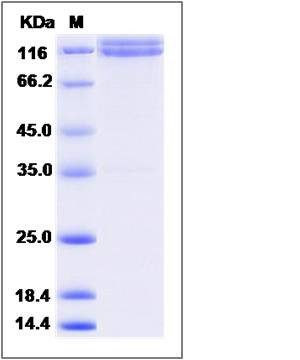Human N-Cadherin / CD325 / CDH2 Protein (His & Fc Tag)
CD325,CDHN,CDw325,NCAD
- 100ug (NPP4098) Please inquiry
| Catalog Number | P11039-H03H |
|---|---|
| Organism Species | Human |
| Host | Human Cells |
| Synonyms | CD325,CDHN,CDw325,NCAD |
| Molecular Weight | The secreted recombinant human CDH2 is a disulfide-linked homodimeric protein. The reduced monomer comprises 813 amino acids and has a predicted molecular mass of 89.9 kDa. As a result of glycosylation, it migrates as an approximately 114 and 119 kDa band in SDS-PAGE under reducing conditions due to glycosylation. |
| predicted N | Asp 160 |
| SDS-PAGE |  |
| Purity | > 70 % as determined by SDS-PAGE |
| Protein Construction | A DNA sequence encoding the human CDH2 (NP_001783.2) (Met 1-Ala 724) was fused with the C-terminal polyhistidine-tagged Fc region of human IgG1 at the C-terminus. |
| Bio-activity | |
| Research Area | Signaling |Signal Transduction |Cytoskeleton / ECM |Cell Adhesion |Cadherins |
| Formulation | Lyophilized from sterile PBS, pH 7.4. 1. Normally 5 % - 8 % trehalose and mannitol are added as protectants before lyophilization. Specific concentrations are included in the hardcopy of COA. |
| Background | Cadherins are calcium dependent cell adhesion proteins, and they preferentially interact with themselves in a homophilic manner in connecting cells. Cadherin 2 (CDH2), also known as N-Cadherin (neuronal) (NCAD), is a single-pass tranmembrane protein and a cadherin containing 5 cadherin domains. N-Cadherin displays a ubiquitous expression pattern but with different expression levels between endocrine cell types. CDH2 (NCAD) has been shown to play an essential role in normal neuronal development, which is implicated in an array of processes including neuronal differentiation and migration, and axon growth and fasciculation. In addition, N-Cadherin expression was upregulated in human HSC during activation in culture, and function or expression blocking of N-Cadherin promoted apoptosis. During apoptosis, N-Cadherin was cleaved into 20-100 kDa fragments. It may provide a novel target for therapies that are directed toward intimal proliferative disorders, including restenosis and vascular bypass graft failure. N-Cadherin is associated with tumor aggressiveness and metastatic potential and may contribute to tumor progression. |
| Reference |
